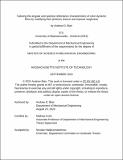Tailoring the angular and spectral reflectance characteristics of color-dynamic films by modifying their photonic texture and topcoat roughness
Author(s)
Blair, Andrew D.
DownloadThesis PDF (5.330Mb)
Advisor
Kolle, Mathias
Terms of use
Metadata
Show full item recordAbstract
Controlling nano- and microscale morphology is essential for tailoring the appearance of structurally colored stretchy films. An effective approach for controlling the optical properties of such color-dynamic photonic films, which are manufactured holographically, is demonstrated using two simple control handles: the texture of the photonic structure and the surface roughness of a transmissive topcoat. Texture of the photonic structure affects the spectral signature and angular distribution of reflected light. Surface roughness of the topcoat affects the angular distribution of incident and reflected light. Fourier optics concepts are harnessed for modeling and predicting the optical characteristics of the materials as a function of their photonic texture and topcoat roughness. The model is verified with data obtained by imaging the angular scattering distribution and spectroscopic analysis of four representative combinations of photonic texture and surface coat roughness. The findings presented in this thesis validate the hypothesis that controlling texture of the photonic film and roughness of its topcoat allows for tailoring the visual appearance of structurally colored materials. This approach provides access to a rich design space of different appearances, including strong iridescence, color constancy with collimated light sources at small angles of incidence, pure and muted colors, and specular and highly diffuse reflections.
Date issued
2024-09Department
Massachusetts Institute of Technology. Department of Mechanical EngineeringPublisher
Massachusetts Institute of Technology